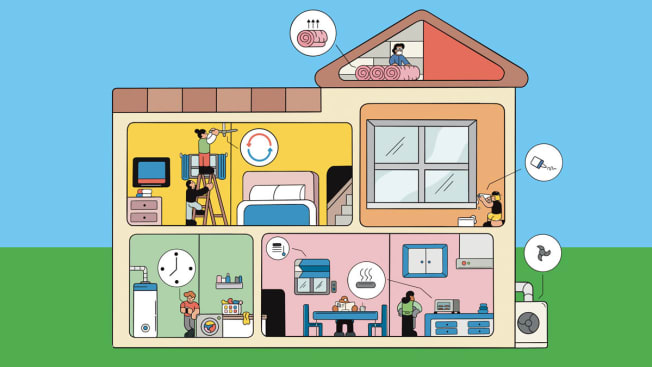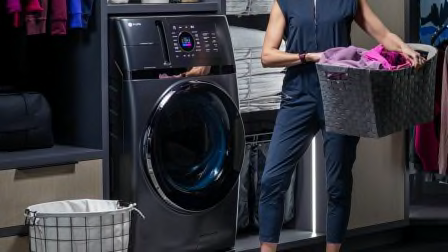Lower Your Home Energy Bills Right Now
You could save over $1,000 a year by making just a few of these easy, low-cost changes around the house
When you shop through retailer links on our site, we may earn affiliate commissions. 100% of the fees we collect are used to support our nonprofit mission. Learn more.

Here’s some good news: Thanks to improvements like more efficient appliances and lighting, we’re using less energy at home than we did 15 years ago, according to the U.S. Energy Information Administration. And this is despite the fact that we own bigger TVs, have more refrigerators, and more of us are using air conditioning.
But when it’s time to pay your monthly bills, it may not seem like you’re catching a break. The average annual price of electricity reached more than 15 cents per kilowatt hour (kWh) nationwide in 2022, according to the most recent data from the EIA—the highest in a decade.
And there’s more not-so-good news: The price of energy is expected to keep going up. The cost will be especially burdensome if more action is not taken to curb climate change, according to an analysis by the consultancy ICF and commissioned by Consumer Reports. That report concluded that energy costs could total $88,000 over the lifetime of a child born in 2024, thanks to a combination of higher gas and electricity prices and people consuming more energy to keep their homes comfortably heated and cooled.
But take heart. There are simple steps you can take to head off those daunting bills. Read on for 15 ways to save right now, from quick DIY projects to savings you can reap just by picking up the phone. And if you’re considering a bigger, more long-term investment—installing a heat pump or solar panels, for example—here’s where to get the intel you need to decide what’s right for your home and budget.
An Easy Way to Save $1,000 a Year
$414: Turn Down Your Water Heater
$243: Join a Community Solar Project
$225: Switch to LED Lightbulbs
$188: Plug Up Air Leaks
Total Savings = $1,070
Pick Up the Phone and Save
Investing the time to make a few phone calls or do a little online research can put you on a path to savings while barely lifting a finger. Here’s how:
Schedule an energy audit to find pricey problem areas. Drafty attics, leaky door frames, and inefficient heating systems can add up to a lot of wasted energy, but they’re not always easy to identify by yourself. That’s where an inspection by a certified energy auditor comes in. They find energy-wasting pain points around your home and suggest improvements. By following the audit’s recommendations—such as putting inexpensive air sealing around windows and doors or upgrading your insulation—you could realize up to a 30 percent reduction in your energy bill. That’s $565 per year, based on the EIA’s 2020 average energy bill of $1,884, the latest data publicly available.
Make Some Simple DIY Improvements
When it comes to saving energy, small moves can add up. What’s more, the cost of many energy improvements, large and small, are eligible for tax credits. (Be sure to keep those receipts!) For exterior doors, windows, skylights, insulation materials, central air conditioning, water heaters, and furnaces, the Energy Efficient Home Improvement Credit ranges from $250 to $1,200 per item, depending on the upgrade. You can also get up to $2,000 for air-source heat pumps and biomass stoves and boilers, and up to $150 for home energy audits. You can claim the credits annually through 2032 for eligible improvements.
Switch to LED lightbulbs. Changing your lighting is a bright idea. When Robin Saidov of Weston, Conn., replaced 50 incandescent bulbs in her home, the family saved $100 a month on electricity and broke even before the end of the year. “The lights in my kitchen are on 11 hours a day, and replacing those six bulbs alone accounts for about $30 in savings,” she says. Replacing all of your incandescent bulbs with comparable LED bulbs can save, on average, $225 a year in energy costs, according to the Department of Energy.
Plug up air leaks. Twenty-five to 40 percent of a home’s heating and cooling energy is lost through holes and gaps you might barely notice. But caulking cracks in walls and spaces around baseboards, windows, and doors—at a cost of about $30—can trim at least 10 percent of your energy use, the DOE says. That’s $188 annually, based on EIA figures. Seamus Nally of Fort Collins, Colo., spent less than $100 on weather-stripping windows and around $2,000 getting his attic insulated—and broke even on that investment in about 2½ years. “I notice the biggest difference in my savings during cold months—sometimes up to $80 per month,” he says.
Recharge your batteries. Rechargeable batteries can easily cost double what single-use batteries cost, but can be recharged and reused hundreds of times. Use rechargeables in battery-gobbling devices like game controllers and toys. Rechargeables instead of single-use batteries in an Xbox Wireless Controller will save just a bit in the first year (due to the charger’s cost) but more than $20 in each of the next four years.
Install a smart thermostat. Typically controlled with a smartphone app, these devices regulate your home’s temperature more efficiently and precisely than a traditional programmable model or a thermostat you set manually. You can adjust a smart thermostat even when you’re away from home, programming set hours for your heater or air conditioner to run. Some models use motion sensors and smartphone location data to tell whether you’re home, and they can even learn your preferences over time. According to Energy Star, these devices can lower your heating and cooling bills by an average of 8 percent. Based on EIA data, that’s $65 per year.
Considering a smart thermostat? Here are some models that excelled in CR’s tests.
Help Your Windows Work Harder
In the summer, about three-quarters of the sunlight enters your home through standard double-pane windows as heat, potentially adding to cooling bills. New, ultra-efficient windows can reduce those bills, but they’re pricey—and typically not an option if you rent. Instead, try these fixes:
Apply easy-to-install solar film to your windowpanes. This is particularly effective on east- and west-facing windows to screen out the sun’s rays without disrupting your view. Adding window film may cut energy costs in older homes by up to 10 percent, says the International Window Film Association, an industry group. Plus, it will help prevent your furniture, fabrics, and artwork from fading.
Add high-efficiency cellular shades. A 2018 study by the Pacific Northwest National Laboratory found that these "honeycomb" window shades cut up to 25 percent of cooling costs when used consistently. That translates to $75 a year, on average, based on EIA data on air-conditioning expenditures. Find efficient shades through the Attachments Energy Rating Council.
Draw the drapes on hot days. You can reduce the heat from the sun that enters your home by up to 33 percent, the DOE says. To get that level of benefit, though, you’ll need to use medium-colored curtains backed with white plastic.
Sip—Don't Guzzle—Energy
Do you really need to heat up your whole oven to reheat some fries? Is it hot enough to require air conditioning, or will a light breeze keep you comfortable? Keeping track of your energy use and swapping out devices that use a lot of energy for those that consume less could help cut your monthly bill down to size.
Keep an eye on your actual usage. Many of us are in the dark about how much energy our most-used devices eat up. Personal electricity usage monitors will give you detailed data on which devices draw the most power—like space heaters and video game consoles—and can cost as little as $20. Simply plug the monitor into a standard 120-volt outlet and the appliance into the monitor. If the information helps you shift your behavior and reduce your electricity consumption by just 15 percent, you’ll break even on the investment within about a month and could eventually save about $243 per year, based on 2022 EIA electricity data.
Lower the setting on your water heater. You could save more than $400 a year (without sacrificing comfort) by resetting an older water heater from 140° F, a common setting in the past, to 120° F. The DOE says that can cut annual energy costs from 4 to 22 percent. Based on EIA data, that’s a $75 to $414 savings.
Get more from your ceiling fan. You probably know that running a ceiling fan counterclockwise can cool a room with just a fraction of the energy required by an air conditioner. But don’t stop using it when the days turn cooler. Just reverse the direction so that the blades turn clockwise to recirculate warm air trapped near the ceiling. If using a fan means that you can adjust your thermostat at least 7 degrees from its normal setting for at least 8 hours a day, you can save up to 10 percent on heating and cooling, the DOE says. That’s $82 annually, based on EIA estimates. If you’re considering installing a ceiling fan, here are some top-rated models from CR’s tests.
Don’t heat up your full-sized oven. Do you really need your range to roast that chicken? It’s often easy to adapt a recipe to use a countertop appliance instead, like a toaster oven or microwave, especially if you’re cooking only for one or two. Smaller kitchen tools like these can save you time and money because they slash or eliminate preheating. And you won’t warm up your home on a hot day, which might reduce your cooling needs.
The following toaster ovens and microwaves are versatile options that performed well in CR’s tests.
Editor’s Note: A version of this article appeared in the May/June 2024 issue of Consumer Reports Magazine.





















